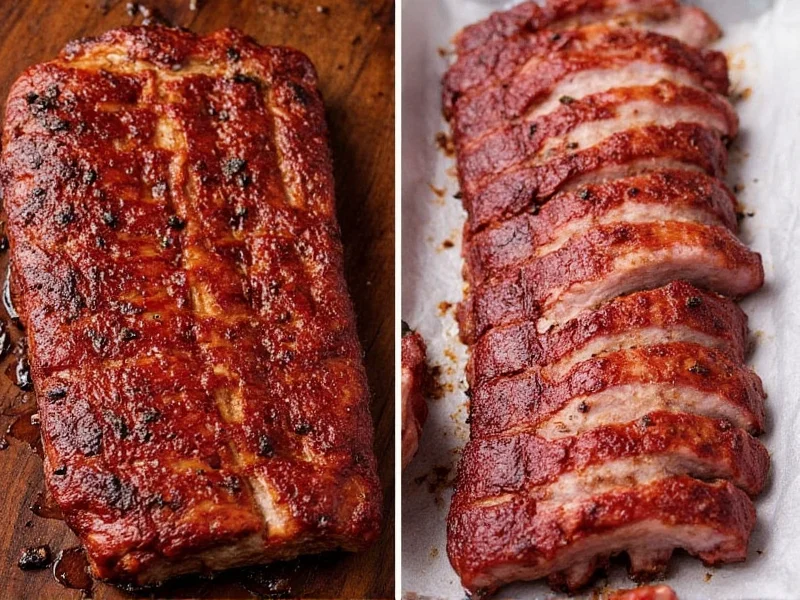When choosing between baby back ribs and spare ribs, understanding their fundamental differences is crucial for both purchasing and cooking success. These two popular pork cuts originate from different parts of the pig, resulting in distinct characteristics that affect flavor, texture, and preparation methods.
Anatomy and Origin
Baby back ribs (also called loin back ribs or top loin ribs) are cut from the area where the rib meets the spine, right below the loin muscle. This positioning makes them the most tender rib cut since these muscles aren't heavily used by the pig. They're typically 3-6 inches long and curved in shape.
Spare ribs (sometimes called side ribs or belly ribs) come from the lower portion of the pig's rib cage, extending from the breastbone to the shoulder blade. This cut includes the sternum, costal cartilage, and rib tips, making them larger and flatter than baby backs. Butchers often remove the hard breastbone but leave the softer cartilage.
Physical Characteristics Comparison
| Characteristic | Baby Back Ribs | Spare Ribs |
|---|---|---|
| Size | Smaller (3-6 inches long) | Larger (6-8 inches long) |
| Meat-to-Bone Ratio | Higher meat content (leaner) | More bone, more fat |
| Bone Structure | Curved, shorter bones | Straighter, longer bones with cartilage |
| Fat Content | Less marbling, leaner | More marbling, higher fat content |
| Weight per Rack | 1.5-2.5 lbs | 2.5-4 lbs |
Flavor and Texture Profile
Baby back ribs offer a milder pork flavor with exceptional tenderness. Their leaner composition means they cook faster but can dry out if overcooked. The meat separates easily from the bone when properly prepared, making them ideal for beginners or those who prefer less chewy texture.
Spare ribs deliver a richer, more robust pork flavor due to their higher fat content. The additional marbling creates incredible juiciness when cooked properly, though they require longer cooking times to render the fat and soften the connective tissue. Many barbecue enthusiasts prefer spare ribs for their authentic, hearty flavor profile that stands up well to bold rubs and sauces.
Cooking Recommendations
For baby back ribs, the 3-2-1 method works exceptionally well: 3 hours indirect heat, 2 hours wrapped in foil, and 1 hour unwrapped with sauce. Their smaller size means they typically cook in 4-6 hours at 225°F. Because they're leaner, wrapping them in foil or butcher paper during cooking helps prevent drying out.
Spare ribs benefit from longer cooking times of 5-7 hours at the same temperature. Their higher fat content requires proper rendering, which happens best with slow, low-temperature cooking. Many pitmasters recommend removing the membrane on spare ribs for better smoke penetration and more tender results. The St. Louis cut (trimmed spare ribs with squared edges) offers a more uniform shape that cooks more evenly.
Purchasing Guidance
When selecting baby back ribs, look for consistent meat coverage across the rack with minimal bone exposure. The meat should appear pinkish-red with fine marbling. Avoid racks with excessive fat deposits or grayish discoloration.
For spare ribs, seek out racks with even fat distribution throughout rather than large pockets of fat. The meat should be firm to the touch with a rich red color. Many butchers offer St. Louis cut spare ribs, which have the hard breastbone and rib tips removed for a more uniform rectangular shape that's easier to cook evenly.
Common Misconceptions
Many people mistakenly believe baby back ribs come from younger pigs, but the "baby" refers to their size, not the pig's age. Both cuts come from market-weight hogs. Another misconception is that spare ribs are "leftover" cuts - the name actually comes from the German word "springen" meaning to spring or bend, referring to their shape.
While baby backs often command higher prices per pound, spare ribs typically offer better value considering their larger size and richer flavor. Understanding these differences between baby back ribs and spare ribs helps you make informed decisions based on your cooking method, time constraints, and flavor preferences.











 浙公网安备
33010002000092号
浙公网安备
33010002000092号 浙B2-20120091-4
浙B2-20120091-4